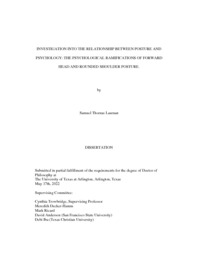| dc.description.abstract | Embodied cognition speaks to the notion that the mind and body are inherently linked, and directly influence one another. Nonverbal communication experts hold the thought that sustaining chronic postures can impact an individual’s psychological disposition and vice versa. Therefore, the potential to intervene on these postures from a musculoskeletal rehabilitation perspective provides the opportunity to improve not only an individual’s posture, but also their psychological state.
Forward head posture (FHP) and rounded shoulder posture (RSP) are common postural adaptations that occur from musculoskeletal dysfunction, and often lead to acute and chronic changes that can be a precursor to etiological pathologies. Although these have traditionally been thought of as a musculoskeletal problem by healthcare practitioners, nonverbal communication and psychology literature explain that these two postures are indicative of specific psychological dispositions.
Nonverbal communication literature speaks to these two postures as denoting submissiveness in individuals. Specifically, characteristics of FHP and RSP are linked to anxiety, depression, and sadness which can cause changes in muscle tonicity, gait, emotional states, and cognitive processing. Therefore, understanding the link between postural abnormalities and an individual’s mindset could provide the foundation for specific posture-based rehabilitation to alleviate the negative psychological impacts posture has.
Study 1 (Chapter 2) identifies the need for postural improvement in college-aged populations. One hundred and sixty-one participants aged 19-26 completed a survey asking self-reported ratings of posture, their desires to improve posture, their levels of knowledge about postural rehabilitation techniques, and their current level of neck disability. Eighty-nine percent of participants wished their posture was better, 94% and 96% identified the need to improve their sitting and standing posture, respectively, and 35% were classified as having mild or moderate disability according to the Neck Disability Index. Amongst the rehabilitation techniques, the more integrative modalities such as the Feldenkrais and Alexander methods, only were familiar to 3.1% of the participants.
Previous literature demonstrated a variety of neck strengthening programs were successful in improving postural measures. However, in exploring different exercise techniques, a distinct lack of neuromuscular integration (NI) techniques was evident. Therefore, a review was necessary. Study 2 (Chapter 3) encompasses a systematic review of the various studies that utilized a NI approach to the rehabilitation of both FHP and RSP. Only 6 articles were identified within the specified range - 4 for FHP and 2 for RSP. 184 articles were excluded from the analysis, and the review highlighted the need for more NI-based studies dedicated to the rehabilitation of upper body postural dysfunctions to be explored.
Study 3 (Chapter 4) compares the psychological measures between individuals with FHP and without FHP as measured by a myriad of patient-rated outcome scores. One hundred and twenty-one healthy, college-aged students were split into bad posture (n=65) and good posture (n=56) groups using a craniovertebral angle (CVA) measurement of ≤50º denoting FHP. Significant differences between groups were seen for Neck Disability Index (NDI) and the PROMIS-29 scales for measures of anxiety, fatigue, sleep disturbance, and satisfaction with social role – all of which had small to moderate effect sizes according to the Cohen’s d metric. This study provided the rationale that there are distinct differences between psychological measures in healthy college-aged students for those with and without FHP.
Finally, Study 4 (Chapter 5) investigated the effect of correcting FHP using a NI rehabilitation technique versus general exercise or no exercise. Baseline measures were obtained for CVA, scapular index, shoulder range of motion, deep cervical flexor endurance, and psychological measures: Neck Disability Index (NDI), General Anxiety Disorder – 7 (GAD-7), Dispositional Positive Emotion Scale – Pride (DPES), and the Patient Rated Outcome Measurement Information System – 29 (PROMIS-29). Participants were randomly assigned to one of three treatments: intervention (NI rehabilitation), general exercise, and a control group. Follow-up assessments were collected after 9 weeks. The only significant improvement was associated with the intervention group for CVA, however overall, the intervention group demonstrated more consistent improvement in the variables measured than the general exercise or the control. | |


